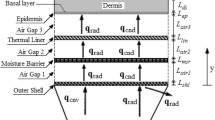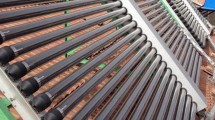Abstract
Overall resistances for heat and vapor transport in a multilayer garment depend on the properties of individual layers and the thickness of any air space between layers. Under uncomplicated, steady-state conditions, thermal and mass fluxes are uniform within the garment, and the rate of transport is simply computed as the overall temperature or water concentration difference divided by the appropriate resistance. However, that simple computation is not valid under cool ambient conditions when the vapor permeability of the garment is low, and condensation occurs within the garment. Several recent studies have measured heat and vapor transport when condensation occurs within the garment (Richards et al. in Report on Project ThermProject, Contract No. G6RD-CT-2002-00846, 2002; Havenith et al. in J Appl Physiol 104:142–149, 2008). In addition to measuring cooling rates for ensembles when the skin was either wet or dry, both studies employed a flat-plate apparatus to measure resistances of individual layers. Those data provide information required to define the properties of an ensemble in terms of its individual layers. We have extended the work of previous investigators by developing a rather simple technique for analyzing heat and water vapor transport when condensation occurs within a garment. Computed results agree well with experimental results reported by Richards et al. (Report on Project ThermProject, Contract No. G6RD-CT-2002-00846, 2002) and Havenith et al. (J Appl Physiol 104:142–149, 2008). We discuss application of the method to human subjects for whom the rate of sweat secretion, instead of the partial pressure of water on the skin, is specified. Analysis of a more complicated five-layer system studied by Yoo and Kim (Text Res J 78:189–197, 2008) required an iterative computation based on principles defined in this paper.




Similar content being viewed by others
Notes
In this paper, the partial pressure of water, p i, is the product of the mole fraction of water and the total pressure. The vapor pressure of water, p v,i, is defined as the pressure of water vapor in equilibrium with liquid water. It is a function of temperature.
References
Bird RB, Stewart WE, Lightfoot EN (2001) Transport phenomena, 2nd edn. Wiley, New York
de Dear RJ, Arens E, Hui Z, Oguro M (1996) Convective and radiative heat transfer coefficients for individual human body segments. Int J Biometeorol 40:141–156
Farnworth B (1986) A numerical model of the combined diffusion of heat and water vapour through clothing. Text Res J 77:653–665. doi:10.1177/004051758605601101
Fukazawa T, Kawamura H, Tochihara Y, Tamura T (2003a) Water vapour transport through textiles and condensation in clothes at high altitudes–combined influence of temperature and pressure simulating altitude. Text Res J 73:657–663. doi:10.1177/004051750307300801
Fukazawa T, Kawamura H, Tochihara Y, Tamura T (2003b) Experiment and analysis of combined heat and water vapour transfer through clothes with condensation. Text Res J 73:774–780. doi:10.1177/004051750307300905
Havenith G, Richards MG, Wang X, Broede P, Candas V, den Hartog E, Holmer I, Kuklane K, Meinander H, Nocker W (2008) Apparent latent heat of evaporation from clothing: attenuation and “heat pipe” effects. J Appl Physiol 104:142–149. doi:10.1152/japplphysiol.00612.2007
Lotens WA, van de Linde FJG, Havenith G (1995) Effects of condensation in clothing on heat transfer. Ergonomics 38:1114–1131. doi:10.1080/00140139508925177
Nishi Y, Gagge AP (1970) Direct evaluation of convective heat transfer coefficient by naphthalene sublimation. J Appl Physiol 29:830–838
Richards M, Meinander H, Broede P, Candas V, den Hartog E, Holmer I, Nocker W, Havenith G (2002) Study of materials to investigate the effects of moisture on the heat transfer through protective clothing. Report on Project ThermProject, Contract No. G6RD-CT-2002-00846. EMPA Materials Science and Technology, Switzerland
Rumford B (1804) An enquiry concerning the nature of heat, and the mode of its communication. Philos Trans R Soc Lond 94:77–182. doi:10.1098/rstl.1804.0009
Wakitani S (1997) Development of multicellular solutions in natural convection in an air-filled vertical cavity. J Heat Transfer 119:97–101. doi:10.1115/1.2824106
Yoo S, Kim E (2008) Effects of multilayer clothing system array on water vapor transfer and condensation in cold weather clothing ensemble. Text Res J 78:189–197. doi:10.1177/0040517507078793
Author information
Authors and Affiliations
Corresponding author
Rights and permissions
About this article
Cite this article
Wissler, E.H., Havenith, G. A simple theoretical model of heat and moisture transport in multi-layer garments in cool ambient air. Eur J Appl Physiol 105, 797–808 (2009). https://doi.org/10.1007/s00421-008-0966-5
Accepted:
Published:
Issue Date:
DOI: https://doi.org/10.1007/s00421-008-0966-5




